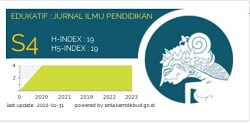An Analysis of Students’ Speaking Anxiety in EFL Classroom: A Mixed-Method Study
Abstract
The study aims to investigate the students’ speaking anxiety levels, find the effect of anxiety, and identify the factors influencing students’ speaking participation. This study involved 62 students in the second semester of the English Education Department, UIN Syarif Hidayatullah Jakarta. This study employed a mixed-method design. To gather the data, a set of questionnaires was utilized based on the Foreign Language Speaking Anxiety Scale by (Horwitz et al., 1986) and an interview. The result of the FLCAS questionnaire classified the category of student anxiety. There were 8 students categorized as very anxious level, 29 students as anxious level, 23 students as mildly anxious level, and 2 students as relaxed level. Students with mildly anxious levels and very anxious levels were interviewed to probe richer data. Further, the study found the effect of students’ speaking anxiety on their speaking participation: considering the idea they want to express, refusing to ask or argue, and being hesitant to participate. This study also found several factors influencing students’ speaking participation, such as English proficiency level, students’ low self-esteem, afraid of making mistakes, lack of preparation, motivation, the method used, and lecturer's attitude
Keywords
Full Text:
PDFReferences
Abrar, M. (2018). An Investigation into Indonesian EFL University Students’ Speaking Anxiety. JEELS (Journal of English Education and Linguistics Studies, 4(2), 221–248.
Akkakoson, S. (2016). Speaking anxiety in English conversation classrooms among Thai students. Malaysian Journal of Learning and Instruction, 13(1), 63–82. https://doi.org/https://doi.org/10.32890/mjli2016.13.1.4
Al, A. M. M. A. N. (2016). Problems and Difficulties of Speaking That Encounter English Language Students at Al Quds Open University. International Journal of Humanities and Social Science Invention, 5(12), 100.
Boonkit, K. (2010). Enhancing The Development of Speaking Skills for Non-Native Speakers of English. Procedia - Social and Behavioral Sciences, 2(2), 1305–1309. https://doi.org/10.1016/j.sbspro.2010.03.191
Bozoğlan, H., & Yılmaz, D. (2016). English Language Teaching. Springer Singapore. https://doi.org/10.1007/978-981-10-2519-8_7
Chi, H. T., & Mai, L. X. (2020). Suggestions for Promoting Students’ Participation in English Speaking Classes: Students’ Perceptions. European Journal of Education Studies, 7(11), 514–534. https://doi.org/10.46827/ejes.v7i11.3378
Creswell, W. J. (2012). Planning, Conducting, and Evaluating Quantitative and Qualitative Research (4th Editio). Pearson Education, Inc.
Debreli, E., & Demirkan, S. (2015). Sources and Levels of Foreign Language Speaking Anxiety of English as a Foreign Language University Students with regard to Language Proficiency and Gender. International Journal of English Language Education, 4(1), 49. https://doi.org/10.5296/ijele.v4i1.8715
Felicity, M. (2018). Speaking Anxiety and Its Effects on Participation in Group Discussions in L2 Classrooms. International Journal of English Language Teaching, 6(3), 20–33.
Hidayat, D. N., Hasanah, U., Eviyuliwati, I., & Septiawan, Y. (2022). An Exploration of Students’ Foreign Language Anxiety in English Classroom. Jurnal Pendidikan Progresif, 12(1), 163–173.
Horwitz, E. K., Horwitz, M. B., & Cope, J. (1986). Foreign language classroom anxiety. The Modern Language Journal, 70(2), 125–132.
Kurniatillah, R. E., Rafika, Z., Husna, N., Hidayat, D. N., & Fitriah, F. (2022). Assessing Students’ Speaking Ability Using Communicative Language Testing Approach on Secondary Level in the Pandemic Era. Edukatif: Jurnal Ilmu Pendidikan, 4(3), 3927–3937.
Mufaridah, F. (2017). Students’ Activity Involvement for Speaking Ability Improvement. 1–6. http://repository.unmuhjember.ac.id/13032/1/2017-ELLITE-Students%27 Activity Involvement for Speaking Ability Improvement.pdf
Pradestina, S. P., & Agustin, A. (2020). The Factors Influencing Grade VIII Students’ Verbal Participation In English Class. Scholaria: Jurnal Pendidikan Dan Kebudayaan, 10(3), 244–250. https://doi.org/10.24246/j.js.2020.v10.i3.p244-250
Richards, J. C. (2008). Language Teaching. Cambridge University Press. https://doi.org/10.1017/S0261444802211829
Sadiku, L. M. (2015). The Importance of Four Skills Reading, Speaking, Writing, Listening in a Lesson Hour. European Journal of Language and Literature. https://doi.org/10.26417/ejls.v1i1.p29-31
Siregar, R. K. (2019). Students’ anxiety on their public speaking. English Education : English Journal for Teaching and Learning, 7(1), 69–80. https://doi.org/https://doi.org/10.24952/ee.v7i01.1654
Sutarsyah, C. (2017). An Analysis of Student’s Speaking Anxiety and its Effect on Speaking Performance. IJELTAL (Indonesian Journal of English Language Teaching and Applied Linguistics), 1(2), 143. https://doi.org/10.21093/ijeltal.v1i2.14
Thi, T., Loan, T., & Tuyen, L. Van. (2020). Factors Causing students’ Inhibition in English Speaking Performance. International Journal on Studies in English Language and Literature, 8(4), 1–10. https://doi.org/10.20431/2347-3134.0804001
Woodrow, L. (2006). Anxiety and Speaking English as a Second Language. RELC Journal, 37(3), 308–328. https://doi.org/10.1177/0033688206071315
DOI: https://doi.org/10.31004/edukatif.v4i5.2999
Article Metrics
Abstract view : 627 timesPDF - 229 times
Refbacks
- There are currently no refbacks.
Copyright (c) 2022 Khoirzady Taqwa, Didin Nuruddin Hidayat, Zaharil Anasy, Muhammad Syafii S

This work is licensed under a Creative Commons Attribution-ShareAlike 4.0 International License.






1.png)